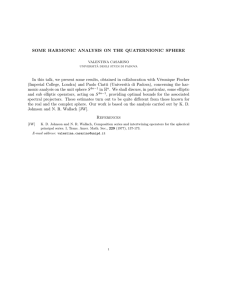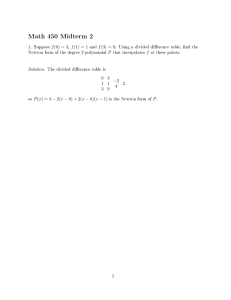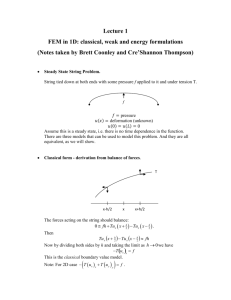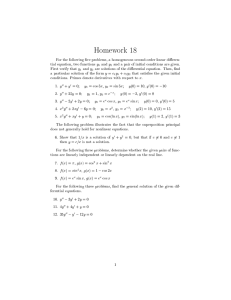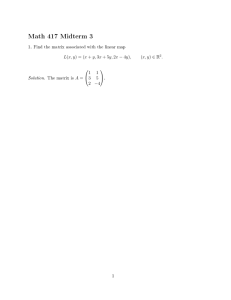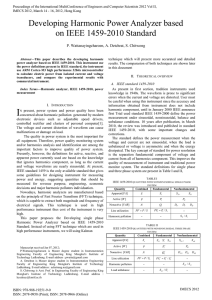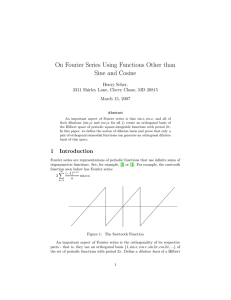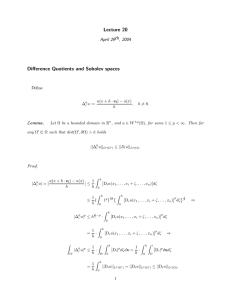Lecture 0
advertisement
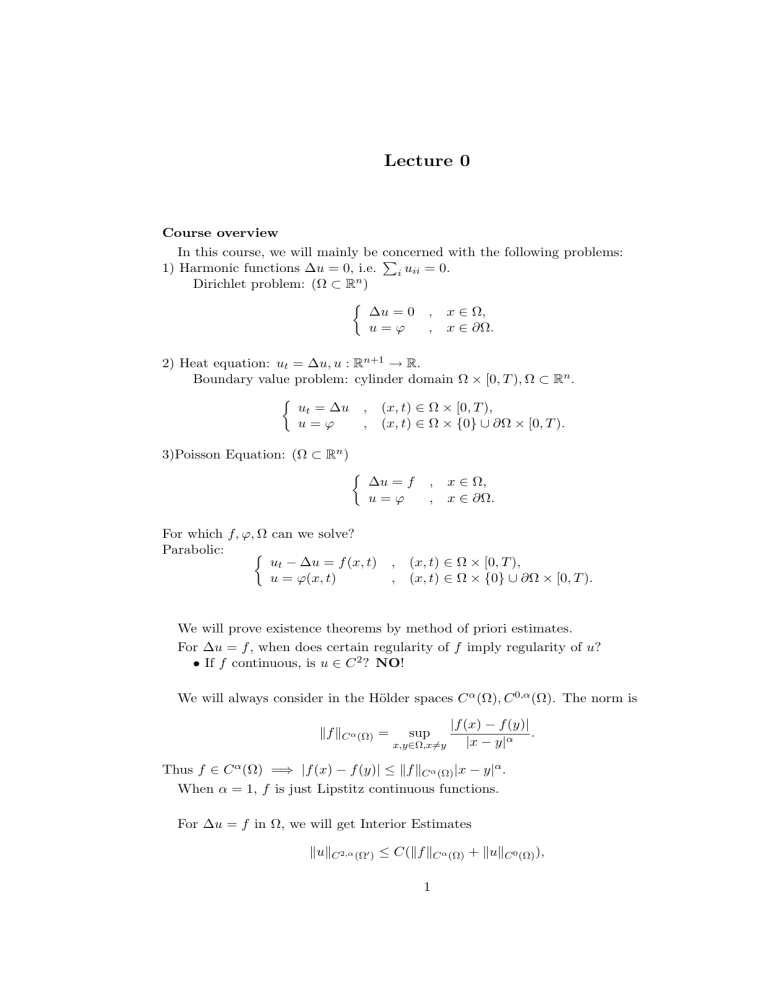
Lecture 0
Course overview
In this course, we will mainly be concerned
with the following problems:
�
1) Harmonic functions Δu = 0, i.e. i uii = 0.
Dirichlet problem: (Ω ⊂ Rn )
�
Δu = 0 , x ∈ Ω,
u=ϕ
, x ∈ ∂Ω.
2) Heat equation: ut = Δu, u : Rn+1 → R.
Boundary value problem: cylinder domain Ω × [0, T ), Ω ⊂ Rn .
�
ut = Δu , (x, t) ∈ Ω × [0, T ),
u=ϕ
, (x, t) ∈ Ω × {0} ∪ ∂Ω × [0, T ).
3)Poisson Equation: (Ω ⊂ Rn )
�
Δu = f
u=ϕ
, x ∈ Ω,
, x ∈ ∂Ω.
For which f, ϕ, Ω can we solve?
Parabolic:
�
ut − Δu = f (x, t) , (x, t) ∈ Ω × [0, T ),
u = ϕ(x, t)
, (x, t) ∈ Ω × {0} ∪ ∂Ω × [0, T ).
We will prove existence theorems by method of priori estimates.
For Δu = f , when does certain regularity of f imply regularity of u?
• If f continuous, is u ∈ C 2 ? NO!
We will always consider in the Hölder spaces C α (Ω), C 0,α (Ω). The norm is
�f �C α (Ω) =
sup
x,y∈Ω,x=y
�
|f (x) − f (y)|
.
|x − y|α
Thus f ∈ C α (Ω) =⇒ |f (x) − f (y)| ≤ �f �C α (Ω) |x − y |α .
When α = 1, f is just Lipstitz continuous functions.
For Δu = f in Ω, we will get Interior Estimates
�u�C 2,α (Ω� ) ≤ C(�f �C α (Ω) + �u�C 0 (Ω) ),
1
where Ω� ⊂⊂ Ω, C = C(Ω, Ω� ).
Notion of weak solution:
�
�
Δu = f weakly on Ω if Ω uΔϕ = Ω ϕf, ∀ϕ ∈ Cc2 (Ω), here u ∈ L1loc (Ω).
Regularity theorem: If u is a weak solution, then u should has as much regularity
as the priori estimates.
In practical problems, it’s usually easy to prove existence of weak solutions.
The harder problem: prove weak solution is regular, and therefore solves the original
equation strongly.
In general, the global estimates should depend on ∂Ω and ϕ:
�
Δu = f , x ∈ Ω,
u=ϕ
, x ∈ ∂Ω.
f ∈ C α (Ω). Assume ϕ is the restriction of a C 2,α function on Rn to ∂Ω, i.e. ϕ has a
C 2,α extension, and ∂Ω is C 2,α smooth. Then u ∈ C 2,α (Ω) and
�u�C 2,α (Ω) ≤ C(�f �C 2,α (Ω) + �u�C 0 (Ω) + �ϕ�C 2,α (∂Ω) ).
�
1
Lp theory: Δu = f, f ∈ Lp (Ω).(( Ω |f |p ) p < ∞)
If u is a weak solution. Does 2nd order derivation of u belong to Lp , i.e.
�
1
( |D2 u|p ) p < ∞ ?
1<p<∞
Ω
We can get
�u�W 2,p (Ω� ) ≤ C(�f �Lp + �u�Lp ).
We just look at Δ. The next is more general elliptic operators:
�
�
Lu =
aij (x)Dij u +
bi (x)Di u + c(x)u = f.
i,j
i
We also consider the following problems:
�
Lu = f , x ∈ Ω,
u=ϕ
, x ∈ ∂Ω.
�
ut − Lu = f (x, t) , (x, t) ∈ Ω × [0, T ),
u = ϕ(x, t)
, (x, t) ∈ Ω × {0} ∪ ∂Ω × [0, T ).
2
We call L is uniformly elliptic if ΛI ≥ (aij ) ≥ λI, λ > 0.
Schauder Theory: L is uniformly elliptic, aij , bi , c ∈ C α (Ω), then
�u�C 2,α (Ω� ) ≤ C(�f �C α (Ω) + �u�C 0 (Ω) ).
Idea: Assuming coefficients are all C α , locally L is close to a constant coefficients op­
erator.
Maximum principle: Bound C 0 norm of solution in terms of boundary data of f .
�u�C 0 (Ω) ≤ C(�f �C 0 (Ω) + sup |ϕ|).
This is an A Priori estimate:
I) Assume solution exists;
II) Prove solutions satisfies a priori bounds;
III) Therefore the solution exists.
Motivation: If you want to completely understand Perelman’s proof of Poincaré
conjecture, you have to know this stuff.
∂
g = −2Ric
∂t
∂
gij ∼ Δg gij + lower terms.
∂t
Fundamental Result: (M 3 , g) compact 3­manifold, then ∃ε > 0 s.t. Ricci flow
system has a smooth solution on M × [0, ε).
(This is called short time existence theorem.)
Examples of harmonic functions in Rn
a) Constant.
b) linear functions.
c) Homogeneous harmonic polynomials: Hk (Rn ).
dimHk (Rn ) = (2k + n − 2) (k+n−3)!
k!(n−2)! .
d) n = 2, the real or image part of holomorphic functions is harmonic.
They are C ∞ . Even more, they are C ω .
e) Fundamental solution
� C
, n > 2,
rn−2
u(x) =
C ln r , n = 2.
3
is harmonic on Rn − {0}.
Fundamental solutions for Laplacian and heat operator
Definition 1
�
Γ(x, y) =
1
n(2−n)ωn |x
1
2π log |x −
− y|2−n
y|
,
,
n > 2,
n = 2.
Γ is harmonic:
∂Γ(x, y)
1
1
=
(xi − y i )
i
∂x
nωn
|x − y |n
∂ 2 Γ(x, y)
1
1
n(xi − y i )(xj − y j )
=⇒
=
{
δ
−
}
ij
∂xi ∂xj
nωn |x − y|n
|x − y |n+2
=⇒ Δx Γ(x, y) = 0
=⇒ Δy Γ(x, y) = 0.
Definition 2
Λ(x, y, t, t0 ) =
|x−y|2
1
4(t0 −t) .
e
(4π |t − t0 |)n/2
We have Λt = ΔΛ:
|x − y|2
n
1
Λ+
Λ
2 (t − t0 )
4(t − t0 )2
xi − y i
Λ
Λ xi =
2(t0 − t)
(xi − y i )2
1
=⇒ Λxi xi =
Λ+
Λ
4(t0 − t)
2(t0 − t)
|x − y |2
n
1
=⇒ ΔΛ = −
Λ+
Λ.
2 (t − t0 )
4(t − t0 )2
Λt = −
Heat Kernel:
K(x, y, t) =
−|x−y|2
1
e 4t .
n/2
(4πt)
It’s easy to check Kt = ΔK.
Suppose u : Rn �→ R is bounded and C 0 , then
�
u(x, t) =
K(x, y, t)u(y)dy
Rn
is
C∞
on
Rn
× (0, ∞) and ut = Δu.
4
